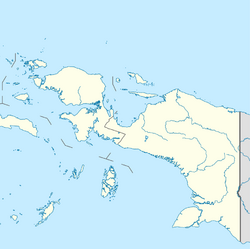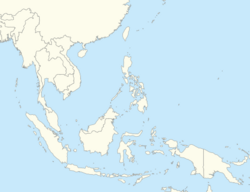Social:Karas language
From HandWiki
Short description: Berau Gulf language spoken in Indonesia
| Karas | |
|---|---|
| Kalamang | |
| Region | West Papua |
Native speakers | 100 (2000)[1] |
Trans–New Guinea
| |
| Language codes | |
| ISO 639-3 | kgv |
| Glottolog | kara1499[2] |
 Karas is classified as Severely Endangered by the UNESCO Atlas of the World's Languages in Danger | |
| Coordinates: [ ⚑ ] 3°28′S 132°41′E / 3.47°S 132.68°E | |
Karas is a divergent Trans–New Guinea language spoken on the biggest of the Karas Islands off the Bomberai Peninsula, that appears to be most closely related to the West Bomberai languages. It is spoken in Antalisa and Mas villages on Karas Island.[3]
Phonology
- The consonants /f/ and /h/ are marginal.
- The vowels /a e i/ are reduced to [ə] in unstressed syllables in fast or casual speech.
Additionally, the following diphthongs are present: /ei/, /oi/, /ou/, /ui/.
Pronouns
Cowan (1953) records the following pronouns for Karas.
| singular | dual | plural | ||
|---|---|---|---|---|
| 1st person |
exclusive | aan | inir | piridok |
| inclusive | aantemu (?) | |||
| 2nd person | kame | ? | kijumene | |
| 3rd person | mame | mjeir | mubameir | |
Visser (2020) records the following pronouns for Karas of Maas village:
|
|
| |||||||||||||||||||||||||||||||||||||||||||||||||||||||||||||
The free possessives and possessive suffixes can occur together.[5]
References
- ↑ "UNESCO Atlas of the World's Languages in danger" (in en). http://www.unesco.org/culture/languages-atlas/en/atlasmap/language-id-2539.html.
- ↑ Hammarström, Harald; Forkel, Robert; Haspelmath, Martin, eds (2017). "Kalamang". Glottolog 3.0. Jena, Germany: Max Planck Institute for the Science of Human History. http://glottolog.org/resource/languoid/id/kara1499.
- ↑ Karas language at Ethnologue (25th ed., 2022)

- ↑ Jump up to: 4.0 4.1 Visser, Eline (2016). A Grammar Sketch of Kalamang with a Focus on Phonetics and Phonology (Master thesis). University of Oslo. urn:nbn:no-54973.
- ↑ Visser, Eline (2020). A Grammar of Kalamang: The Papuan Language of the Karas Islands (PhD thesis). Lund University.
Sources
- Cowan, H. K. J. (1953) (in nl). Voorlopige Resultaten van een Ambtelijk Taalonderzoek in Nieuw-Guinea. 's-Gravenhage: Martinus Nijhoff.
- Visser, Eline (2020). A Grammar of Kalamang: The Papuan Language of the Karas Islands (PhD thesis). Lund University.
- Visser, Eline. 2021. Kalamang dictionary. In: Key, Mary Ritchie & Comrie, Bernard (eds.) The Intercontinental Dictionary Series. Leipzig: Max Planck Institute for Evolutionary Anthropology. (CLDF dataset)
- Visser, Eline. 2022. A grammar of Kalamang. (Comprehensive Grammar Library 4). Berlin: Language Science Press. DOI: 10.5281/zenodo.6499927 https://langsci-press.org/catalog/book/344 . Open Access.
External links
- Timothy Usher, New Guinea World, Kalamang
 |




